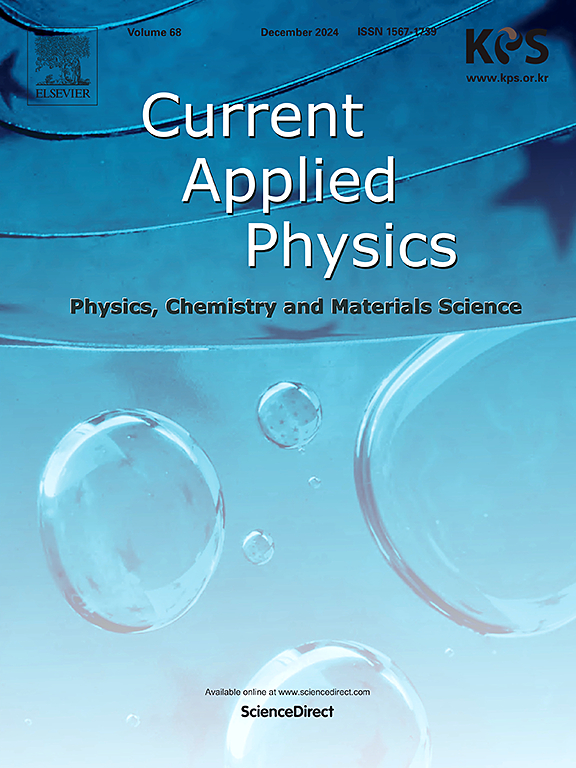Improvement of optoelectrical properties of silicon heterojunction solar cells by using ITO/SiOx DLARC with NH3 plasma treatment
IF 3.1
4区 物理与天体物理
Q3 MATERIALS SCIENCE, MULTIDISCIPLINARY
引用次数: 0
Abstract
Silicon heterojunction (SHJ) solar cells have attracted significant interest due to their high efficiency and low temperature coefficient. Anti-reflective coating (ARC) is used to increase light absorption and short circuit current density (Jsc) of SHJ solar cell. Indium Tin Oixde (ITO) is commonly used ARC coating for SHJ solar cell because ITO has high conductivity and low resistance properties. To enhance the characteristics of the ARC, an additional transparent electrode with a lower refractive index than ITO was deposited. This increases the amount of light refracted into the solar cell, allowing for greater light absorption. This study focuses on enhancing the optical and electrical properties and Jsc by improving the ITO layer and ITO/SiOx double layer ARC on the solar cell. Since SiOx has low moisture stability and a refractive index is lower than 1.5, it is difficult to use it directly in solar cells. Therefore, NH3 plasma post-treatment was applied to develop an ARC suitable for solar cell applications. Using RF/DC power sputtering for ITO and plasma enhanced chemical vapor deposition (PECVD) for SiOx to make Double Layer of Antireflective coating (DLARC) and NH3 plasma treatment. This structure increased transmittance from 86.73 % to 89.6 % between 300 and 1100 nm spectrum. This resulted in a higher Jsc of 39.85 mA/cm2 and a conversion efficiency of 21.8 %. Both simulations and experiments demonstrated that ITO/SiOx DLARC with NH3 plasm post treatment structure offers superior anti-reflection properties compared to single-layer ITO coatings.
用ITO/SiOx DLARC和NH3等离子体处理改善硅异质结太阳能电池的光电性能
硅异质结(SHJ)太阳能电池因其高效率和低温系数低而受到广泛关注。采用抗反射涂层(ARC)提高SHJ太阳能电池的光吸收和短路电流密度(Jsc)。氧化铟锡(ITO)具有高导电性和低电阻性,是SHJ太阳能电池常用的电弧涂层。为了提高电弧的特性,在电弧表面额外沉积了一个折射率比ITO低的透明电极。这增加了进入太阳能电池的光的折射量,允许更多的光吸收。本文主要研究了通过改善ITO层和ITO/SiOx双层ARC来提高太阳能电池的光电性能和Jsc。由于SiOx具有较低的水分稳定性和低于1.5的折射率,因此很难直接用于太阳能电池。因此,采用NH3等离子体后处理技术开发了一种适用于太阳能电池的ARC。采用射频/直流功率溅射对ITO和等离子体增强化学气相沉积(PECVD)对SiOx进行双抗反射涂层(DLARC)和NH3等离子体处理。在300 ~ 1100nm光谱范围内,该结构使透射率从86.73%提高到89.6%。这使得Jsc达到39.85 mA/cm2,转换效率达到21.8%。模拟和实验均表明,与单层ITO涂层相比,具有NH3浆后处理结构的ITO/SiOx DLARC具有更好的抗反射性能。
本文章由计算机程序翻译,如有差异,请以英文原文为准。
求助全文
约1分钟内获得全文
求助全文
来源期刊

Current Applied Physics
物理-材料科学:综合
CiteScore
4.80
自引率
0.00%
发文量
213
审稿时长
33 days
期刊介绍:
Current Applied Physics (Curr. Appl. Phys.) is a monthly published international journal covering all the fields of applied science investigating the physics of the advanced materials for future applications.
Other areas covered: Experimental and theoretical aspects of advanced materials and devices dealing with synthesis or structural chemistry, physical and electronic properties, photonics, engineering applications, and uniquely pertinent measurement or analytical techniques.
Current Applied Physics, published since 2001, covers physics, chemistry and materials science, including bio-materials, with their engineering aspects. It is a truly interdisciplinary journal opening a forum for scientists of all related fields, a unique point of the journal discriminating it from other worldwide and/or Pacific Rim applied physics journals.
Regular research papers, letters and review articles with contents meeting the scope of the journal will be considered for publication after peer review.
The Journal is owned by the Korean Physical Society.
 求助内容:
求助内容: 应助结果提醒方式:
应助结果提醒方式:


